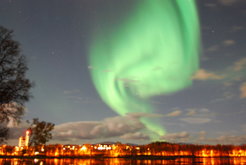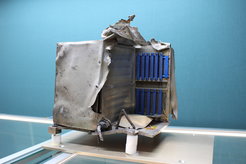Cluster mission: Salsa's last dance
For 24 years, the four Cluster satellites have been studying the magnetosphere. Next Sunday, the first of them will re-enter into Earth's atmosphere.
The research mission of the first of ESA's four Cluster satellites will end on Sunday, September 8, 2024, with its re-entry into the Earth's atmosphere over the South Pacific. Monitored by control centers and telescopes on Earth as well as a research aircraft, the satellite affectionately known as “Salsa” will burn up. The large-scale observation campaign is intended to help understand how disused satellites can be safely and quickly removed from orbit in the future. At the same time, the upcoming fireworks will mark the end of a unique research expedition: for 24 years (instead of the originally planned two years), Salsa has been travelling through Earth's magnetosphere in a “formation dance” with its siblings Rumba, Samba and Tango on elongated ellipses - and has thus witnessed for more than two solar cycles how the magnetic shield protects our planet from direct particle and radiation bombardment from the Sun. The Max Planck Institute for Solar System Research (MPS) in Göttingen contributed the RAPID instrument to the mission.

The end of Salsa's mission will take place under conditions similar to those at the time of the launch 24 years ago: in a phase of particularly high solar activity. Just like back then, our star is currently going through the maximum of its approximately eleven-year activity cycle. In recent months, this has resulted in several violent solar storms; impressive auroras were even visible in Germany. “The current situation is very similar to that at the beginning of the Cluster mission,” recalls MPS scientist Dr. Patrick Daly, RAPID Principal Investigator. Back in November 2001, the Cluster satellites witnessed a particularly violent solar storm. Measurements showed that during such a storm, the bombardment from the Sun squeezes Earth's magnetosphere to half of its usual size. “Such an event had never before been recorded in situ with such precision,” says Daly.
A protective shield in space

The magnetosphere, the sphere of influence of Earth's magnetic field, is huge. While its extent on the side facing the Sun is usually around 65,000 kilometers, its elongated tail extends more than two million kilometers into space. Although the magnetosphere shields Earth from most solar particles, some can penetrate into the inner layers of the atmosphere at the poles, where the magnetic field lines are curved towards Earth's surface. These particles and the magnetic fields carried by the solar wind create a complex interplay of particles, magnetic fields and waves in the magnetosphere. “Before the Cluster mission began, our understanding of Earth's magnetosphere was rather incomplete,” says Daly. “Like no other space mission, Cluster has contributed to our understanding of the structure and dynamics of Earth's magnetosphere,” he adds.
Thanks to its decades-long presence in the magnetosphere, the Cluster mission was able to witness first-hand how our magnetic shield changes under the varying influence of the Sun. Another advantage: the choreography of the four “dancers”. Since 2001, the satellites have been flying in a tetrahedron-shaped formation. The data generated in this way not only provides researchers with a three-dimensional view of the magnetosphere, but also allows to distinguish spatial changes from temporal changes.

For this purpose, the cluster satellites each carry eleven identical scientific instruments on board. The four particle spectrometers from the MPS, known as RAPID (Research with Adaptive Particle Imaging Detectors), determine the distribution and energy of ions and electrons in the magnetosphere. Over the past decades, a detailed overall picture of our Earth's particle environment has emerged in this way. In addition, the RAPID instruments have succeeded for the first time in measuring the distribution of heavy ions such as iron and silicon ions in the magnetosphere. These occur particularly in the inner magnetosphere and their abundance depends strongly on solar activity. And recently, the RAPID data even provided a clue as to how impressive spiral-shaped auroras occur. A group of four researchers led by Dr. Elena Kronberg from Ludwig-Maximilians-Universität München, a former member of the RAPID team at the MPS, identified vortex-like magnetic field structures in the data.
Fiery end to a space Methuselah
“We never expected the cluster satellites to collect data for so many years,” says Daly. As almost all of the instruments were still functional after the originally planned two years of operation, the mission could be extended - time and time again. By now, Cluster has long joined the group of famous “space Methuselahs” including the Voyager and Pioneer space probes, the SOHO solar observatory and the Advanced Composition Explorer ACE. But the years have not left the four cosmic dancers untouched. Like the other scientific instruments, the four RAPID spectrometers are suffering from a few ailments: Some sub-instruments have already failed; the measuring sensitivity has diminished. And last but not least, the satellites are now running out of fuel.

Preparations for the necessary end of the mission have been underway since January. At that time, Salsa was steered onto a course that has caused the satellite to sink a little lower with each orbit. On September 8, the trajectory will be so low that Salsa will break up in Earth's atmosphere. ESA expects the fragments to burn up completely. For now, the satellites Rumba, Samba and Tango will only be switched off; they are scheduled for re-entry in November 2025 and August 2026.
Catastrophic launch
In a way, the imminent, fiery end of the mission is reminiscent of its beginning. Four years before the successful launch in 2000, there was a disaster: The first launch attempt had to be terminated after less than a minute's flight due to a control error in the launch vehicle. The fragments of the exploded rocket - and of the four Cluster satellites on board - came down in a controlled manner over an uninhabited area near the ESA Space Center in French Guiana, South America. One of the destroyed RAPID instruments, which was recovered from the swamps there, is still displayed at the MPS today.

Patrick Daly witnessed the failed launch at the ESA control center in Darmstadt. “We didn't even recognize the spectacular fireworks on the screen and didn't know what was going on until the silence was broken with the words “That was the Cluster Mission”,” he still remembers the nightmarish moment today. Four years later, the joy was all the greater. Daly watched the launch of the first two satellites in July 2000 again from Darmstadt, and witnessed the launch of the second pair in August of the same year in Baikonur, Kazakhstan. An unforgettable experience. “After every successful launch, everyone involved is overjoyed. After all, they have been working towards this moment for years. But with Cluster it was really something very special,” says Daly. The upcoming last dance of Salsa will now take the members of the scientific teams to the Space Astronomy Center (ESAC) near Madrid in the next few days - for one last meeting and another unforgettable moment.
















